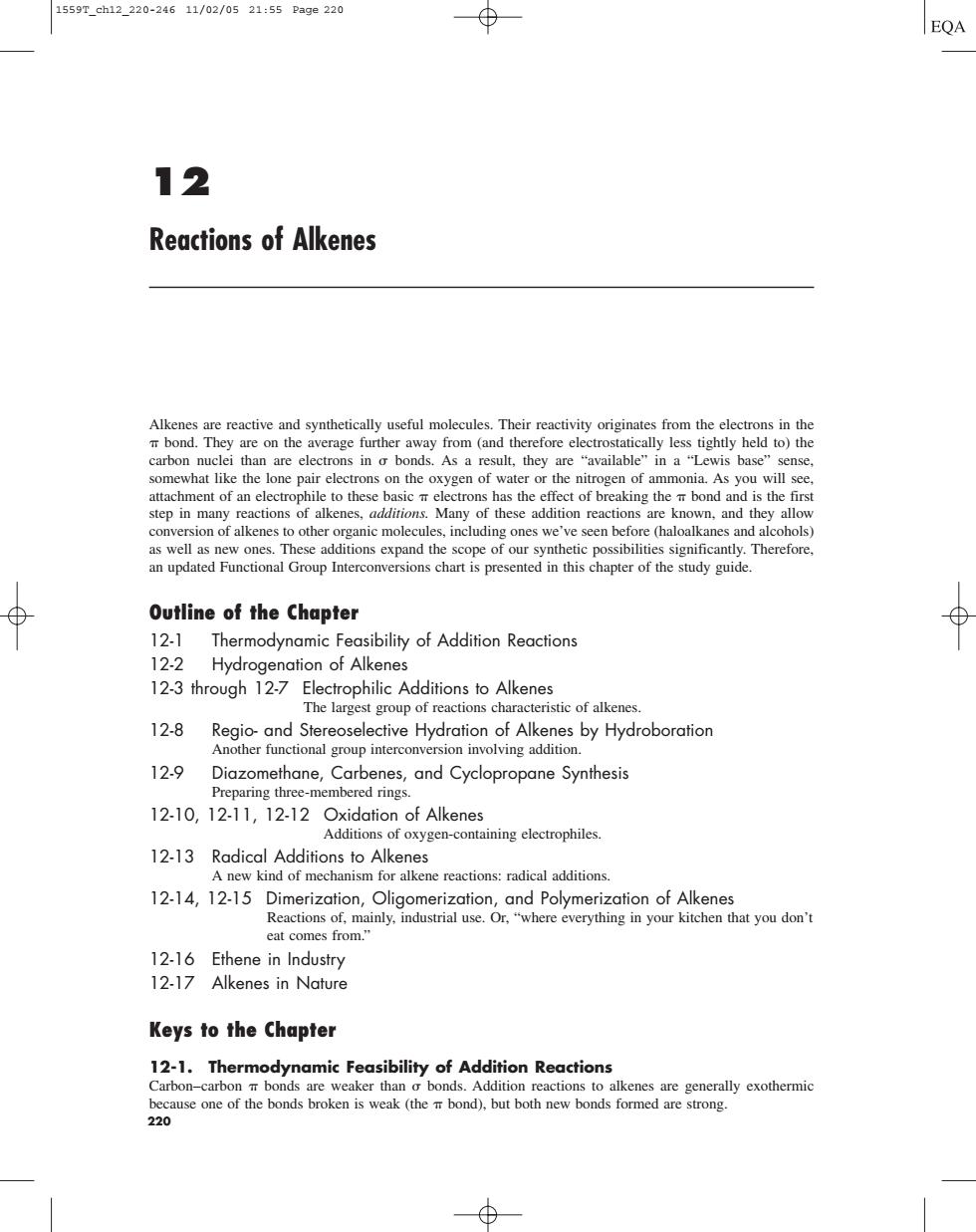正在加载图片...

1559T_ch12_220-24611/02/0521:55Pa9e220 ⊕ EQA 12 Reactions of Alkenes Alkenes s in the t are electrons in bonds.As a result,they are"available"in a"Lewis base" sense lone pai 黑义of teve adi中 known,and they allov es,inciu ing ones we've seen b an updated Functional Group Interconversions chart is presented in this chapter of the study guide. Outline of the Chapter 12-1 Thermodynamic Feasibility of Addition Reactions 12-2 Hydrogenation of Alkenes 12-3 through 12-7 12-8 ReacandSereosdle s by Hydroboration oup inter ving a 12.9 Diazomethane,Carbenes,and Cyclopropane Synthesis ng u 12-10,12-11,12-12 Oxidation of Alkenes of oxygen-containing electrophiles 12-13 Radical Additions to Alkenes d of mechanism for alkene reactions:radical additions 12-14,12-15 Dimerization,Oligomerization,and Polymerization of Alkenes 12-16 Ethene in Industry 12-17 Alkenes in Nature Keys to the Chapter 12-1.Thermodynamic Feasibility of Addition Reactions bond).but on reactions to are generally exothermi 22 use one 12 Reactions of Alkenes Alkenes are reactive and synthetically useful molecules. Their reactivity originates from the electrons in the bond. They are on the average further away from (and therefore electrostatically less tightly held to) the carbon nuclei than are electrons in bonds. As a result, they are “available” in a “Lewis base” sense, somewhat like the lone pair electrons on the oxygen of water or the nitrogen of ammonia. As you will see, attachment of an electrophile to these basic electrons has the effect of breaking the bond and is the first step in many reactions of alkenes, additions. Many of these addition reactions are known, and they allow conversion of alkenes to other organic molecules, including ones we’ve seen before (haloalkanes and alcohols) as well as new ones. These additions expand the scope of our synthetic possibilities significantly. Therefore, an updated Functional Group Interconversions chart is presented in this chapter of the study guide. Outline of the Chapter 12-1 Thermodynamic Feasibility of Addition Reactions 12-2 Hydrogenation of Alkenes 12-3 through 12-7 Electrophilic Additions to Alkenes The largest group of reactions characteristic of alkenes. 12-8 Regio- and Stereoselective Hydration of Alkenes by Hydroboration Another functional group interconversion involving addition. 12-9 Diazomethane, Carbenes, and Cyclopropane Synthesis Preparing three-membered rings. 12-10, 12-11, 12-12 Oxidation of Alkenes Additions of oxygen-containing electrophiles. 12-13 Radical Additions to Alkenes A new kind of mechanism for alkene reactions: radical additions. 12-14, 12-15 Dimerization, Oligomerization, and Polymerization of Alkenes Reactions of, mainly, industrial use. Or, “where everything in your kitchen that you don’t eat comes from.” 12-16 Ethene in Industry 12-17 Alkenes in Nature Keys to the Chapter 12-1. Thermodynamic Feasibility of Addition Reactions Carbon–carbon bonds are weaker than bonds. Addition reactions to alkenes are generally exothermic because one of the bonds broken is weak (the bond), but both new bonds formed are strong. 220 1559T_ch12_220-246 11/02/05 21:55 Page 220��